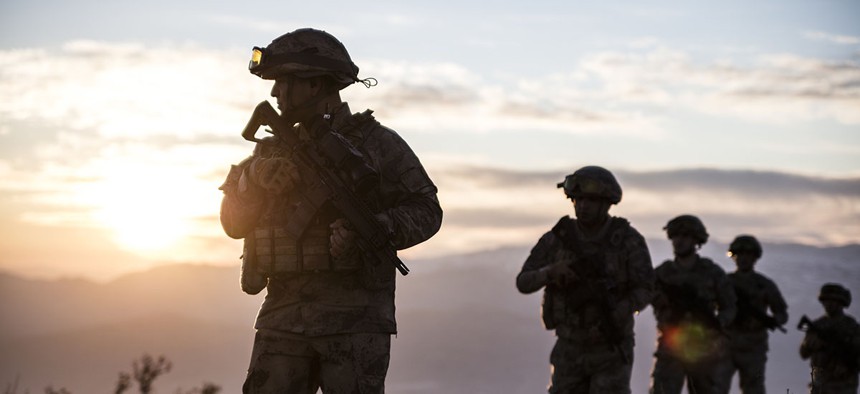sponsor content What's this?

Advanced radar and sensing technologies fill airspace intelligence security gaps
Fortem Technologies will demonstrate its innovative end-to-end system for detecting and thwarting sophisticated aerial threats at AUSA.
Presented by Fortem Technologies
The evolving landscape of unmanned aerial systems (UAS) creates significant societal and logistical changes, impacting defense, national security, disaster response and even package delivery. For the Department of Defense (DoD) and other government entities, counter-UAS innovation is a top priority to protect service members and civilian spaces from increasingly sophisticated threats.
Though UAS threats have been a defense concern for years, the war in Ukraine significantly altered the course of aerial warfare, particularly in terms of small UAS and commercial drones that have been modified and put to use in unanticipated ways.
“What we’re seeing in Ukraine is completely changing the landscape of what people think is possible,” says Jon Gruen, chairman and CEO of Fortem Technologies. “The whole paradigm has shifted.”
In recent comments, Deputy Secretary of Defense Kathleen Hicks underscored the importance of innovation in matching and exceeding new threat capabilities. The DoD’s new “replicator” initiative aims to dramatically accelerate the scaling of all-domain attritable autonomous systems over the next 18-24 months.
“Now is the time to scale with systems that are harder to plan for, harder to hit and harder to beat than those of potential competitors,” Hicks said.
Protecting service members and population centers
Fortem Technologies, a leader in airspace awareness, security and defense, is positioned to meet these needs by moving the airspace intelligence field forward to combat advanced threats across industries and locations.
“We’re seeing the same technology be adapted for various nefarious use cases, whether reconnaissance work at international borders, drones being used to drop contraband into prisons or potential terrorist threats at stadiums,” Gruen says.
This makes comprehensive sensing more critical than ever, requiring a mix of sensor types — some track big-picture environmental activity, while others engage in more specialized, targeted sensing. Both wide area surveillance and targeted sensing must be able to respond to growing UAS threats with high accuracy and fidelity. Fortem is developing a cutting-edge suite of sensors, radars, command and control capabilities and software to address these challenges.
“We’ve been listening to what the markets are telling us on the sensing side in developing our sensor network, and we’ll be rolling out a new longer-range radar at AUSA,” Gruen says. “That’s going to hit a sweet spot for high-fidelity radar that can detect hundreds of systems in populated urban environments.”
As Fortem develops radar and sensors for busy, urban environments, population safety is always top of mind. The Fortem team understands the importance of balancing power with radiation levels low enough to mitigate collateral damage.
“It’s like standing in front of a campfire, to be in front of one of our radars, so it works in populated environments,” Gruen says. “But you still get a level of fidelity and range that you would get out of a very high-powered radar that you would never place in a populated environment for safety reasons.”
A complete, end-to-end system provides seamless protection
As Fortem expands and scales its radar and sensing capabilities to meet growing market demands and evolving threats, the team also continues to enhance its effector offerings, including the DroneHunter F700, the company’s cost-effective, reusable UAS capture system.
“We’ve taken our F700 DroneHunter and increased its capability and survivability in combat environments, enabling it to go after different threats, like higher-altitude, larger drones,” Gruen says. “And we’re working on efforts to mitigate what we anticipate to be drone swarms that we’ll see on the battlefield in the future.”
In planning for the future and supporting Joint All Domain Command and Control (JADC2) efforts, Fortem is taking full ownership of the C-UAS lifecycle, creating an end-to-end system of distributed radar, AI at the edge, deep sensor integration and autonomous drone capture.
“We purpose-build sensors that are going to have the highest effectiveness in the environments we're deployed in, and that's tightly integrated into our command control software, which has also been purpose-built based on user input,” Gruen says.
The result is a complete system that seamlessly surveys, detects, tracks, captures and eliminates UAS threats with minimal damage, whether on the battlefield or in a soccer stadium.
See the system in action at AUSA
At AUSA’s annual meeting, Fortem showcase its recent developments. The new longer-range radar panel, command and control software, and DroneHunter system upgrades will all be highlighted.
“We’ll also roll out a number of different partnerships, including one that will show how we're able to integrate into enterprise-level artificial intelligence platforms that are operating at the city level,” Gruen says. “So integrating all types of different data streams to create predictive analytics for operations in major metropolitan areas. You have a safety aspect of that, but also moving toward making the flow of goods and people in an urban environment more efficient and effective.”
As Gruen notes, even as threats advance and defense needs grow, legitimate UAS applications are also expanding, from drones to assist first responders to various commercial and delivery uses.
“It’s such a rapidly evolving technology area, and now that people have started to absorb this new reality, they’re looking at creative ways to adapt the technologies into all kinds of capabilities,” Gruen says. “We’re heavily in the defense and security market right now, but the commercial applications of this aren’t even fully realized yet. Logistics companies, delivery companies, state level departments of transportation — the breadth of who we can engage with is amazing.”
Learn more about how Fortem Technologies is transforming the airspace intelligence field.
This content is made possible by our sponsor Fortem Technologies; it is not written by and does not necessarily reflect the views of Defense One's editorial staff.
NEXT STORY: GovExecTV: Five Questions with Richard Allen-Miles




